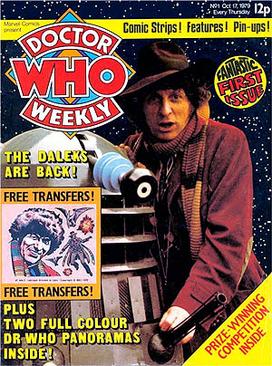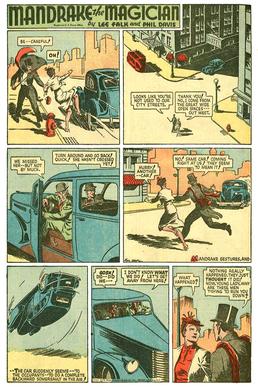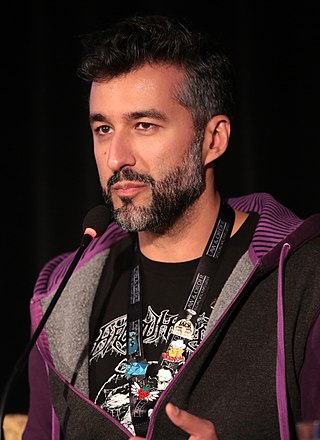
Sergio Aragonés Domenech is a Spanish/Mexican cartoonist and writer best known for his contributions to Mad magazine and creating the comic book Groo the Wanderer.

Dick Tracy is an American comic strip featuring Dick Tracy, a tough and intelligent police detective created by Chester Gould. It made its debut on Sunday, October 4, 1931, in the Detroit Mirror, and it was distributed by the Chicago Tribune New York News Syndicate. Gould wrote and drew the strip until 1977, and various artists and writers have continued it. Dick Tracy has also been the hero in a number of films, including Dick Tracy in which Warren Beatty played the lead in 1990. Tom De Haven praised Gould's Dick Tracy as an "outrageously funny American Gothic", while Brian Walker described it as a "ghoulishly entertaining creation" which had "gripping stories filled with violence and pathos".

Darkwing Duck is an American animated superhero comedy television series produced by Disney Television Animation that first ran from 1991 to 1992 on both the syndicated programming block The Disney Afternoon and Saturday mornings on ABC. A total of ninety-one episodes were aired. It features the adventures of Darkwing Duck, who is the superheroic alter-ego of ordinary suburban duck Drake Mallard.
The Comic Strip are a group of British comedians who came to prominence in the 1980s. They are known for their television series The Comic Strip Presents..., which was labelled as a pioneering example of the alternative comedy scene. The core members are Adrian Edmondson, Dawn French, Rik Mayall, Nigel Planer, Peter Richardson and Jennifer Saunders, with appearances by Keith Allen, Robbie Coltrane, Alexei Sayle and others.

Batman is an American live-action television series based on the DC Comics character of the same name. It stars Adam West as Bruce Wayne/Batman and Burt Ward as Dick Grayson/Robin—two crime-fighting heroes who defend Gotham City from a variety of archvillains. It is known for its camp style, upbeat theme music, and its intentionally humorous, simplistic morality. This included championing the importance of using seat belts, doing homework, eating vegetables, and drinking milk. It was described by executive producer William Dozier as the only situation comedy on the air without a laugh track. The 120 episodes aired on the ABC network for three seasons from January 12, 1966, to March 14, 1968, twice weekly during the first two seasons, and weekly for the third. In 2016, television critics Alan Sepinwall and Matt Zoller Seitz ranked Batman as the 82nd greatest American television series of all time. A companion feature film was released in 1966 between the first and second seasons of the TV show.

Doctor Who Magazine is a magazine devoted to the long-running British science fiction television series Doctor Who. Launched in 1979 as Doctor Who Weekly, the magazine became a monthly publication the following year. Now with 13 issues a year, as well as currently producing triannual deluxe Special Editions (2002–) and Bookazines (2013–), the publication features behind the scenes articles on the TV show and other media, as well as producing its own world famous comic strip. Its founding editor was Dez Skinn, and the incumbent editor is Marcus Hearn, who took over from the magazine's longest-serving editor, Tom Spilsbury, in July 2017. DWM is recognised by Guinness World Records as the longest running TV tie-in magazine, celebrating 40 years of continuous publication on 11 October 2019.

Crazy Magazine is an illustrated satire and humor magazine that was published by Marvel Comics from 1973 to 1983 for a total of 94 regular issues. It was preceded by two standard-format comic books titled Crazy. The magazine's format followed in the tradition of Mad, Sick, Cracked and National Lampoon.

Mandrake the Magician is a syndicated newspaper comic strip, created by Lee Falk before he created The Phantom. Mandrake began publication on June 11, 1934. Phil Davis soon took over as the strip's illustrator, while Falk continued to script. The strip was distributed by King Features Syndicate.
The police procedural, police show, or police crime drama, is a subgenre of procedural drama and detective fiction that emphasizes the investigative procedure of police officers, police detectives, or law enforcement agencies as the protagonists, as contrasted with other genres that focus on non-police investigators such as private investigators.

Lucky Luke is a Western bande dessinée series created by Belgian cartoonist Morris in 1946. Morris wrote and drew the series single-handedly until 1955, after which he started collaborating with French writer René Goscinny. Their partnership lasted until Goscinny's death in 1977. Afterwards, Morris used several other writers until his own death in 2001. Since Morris's death, French artist Achdé has drawn the series, scripted by several successive writers.

A crossover is the placement of two or more otherwise discrete fictional characters, settings, or universes into the context of a single story. They can arise from legal agreements between the relevant copyright holders, unofficial efforts by fans, or common corporate ownership.

Evan Dorkin is an American comics artist and cartoonist. His best known works are the comic books Milk and Cheese and Dork. His comics often poke fun at fandom, even while making it clear that Dorkin is a fan himself.
Spy vs. Spy is a wordless comic strip published in Mad magazine. It features two agents involved in stereotypical and comical espionage activities. One is dressed in white, and the other in black, but they are otherwise identical, and are particularly known for their long, beaklike heads and their white pupils and black sclera. The pair are always at war with each other, using a variety of booby traps to inflict harm on the other. The spies usually alternate between victory and defeat with each new strip. A parody of the political ideologies of the Cold War, the strip was created by Cuban expatriate cartoonist Antonio Prohías, and debuted in Mad #60, dated January 1961. Spy vs. Spy is currently written and drawn by Peter Kuper.
The Star Trek franchise has produced a large number of novels, comic books, video games, and other materials, which are generally considered non-canon.
A countdown is the backward counting to indicate the remaining time before an event occurs.

Paul McClaran Dini is an American screenwriter and comic creator. He has been a producer and writer for several Warner Bros. Animation/DC Comics animated series, most notably Batman: The Animated Series (1992–1995), and the subsequent DC Animated Universe. Dini and Bruce Timm co-created the characters Harley Quinn and Terry McGinnis.

Tom Richmond is an American freelance humorous illustrator, cartoonist and caricaturist whose work has appeared in many national and international publications since 1990. He was chosen as the 2011 "Outstanding Cartoonist of the Year", also known as "The Reuben Award", winner by the National Cartoonists Society.

Michael Manley is an American artist, most notable as a comic strip cartoonist and comic book inker and penciller. Manley currently draws two syndicated comic strips, Judge Parker and The Phantom. He is also known for co-creating the Marvel Comics character Darkhawk.

Kristofer Straub is an American web cartoonist, performer, and content creator. His key web comic projects include Checkerboard Nightmare, Starslip, Chainsawsuit, Broodhollow, and F Chords. Other notable projects include the creepypasta "Candle Cove" as well as collaborations with Scott Kurtz ("Blamimations"), Paul Verhoeven, and Penny Arcade.
This is a list of comics regarding the Star Trek media franchise.












